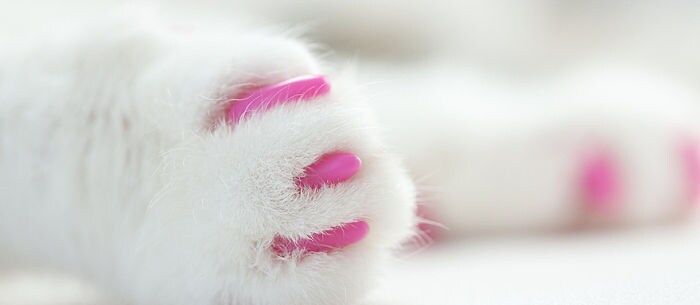Cats like to scratch. It’s instinctive. They scratch to maintain their nails, mark their territory, stretch, and relieve stress. But no one wants a sofa — or an arm — full of scratch marks. How can you live with an indoor cat without declawing? Fortunately, there are safe and effective alternatives to declawing cats so they can live indoors with you without tearing your furniture to pieces.
What Is Declawing?
“Declawing (aka onychectomy) is a surgical procedure that involves a full amputation of the last bone of each toe on a cat to remove the nail,” cat veterinarian Dr. Nicole Martell-Moran of the Cat Care Clinic explains. Many animal groups, such as the Humane Society of the United States, condemn declawing. The methods used aren’t risk-free and can result in health or behavior problems for cats.
In a study Dr. Moran completed, “out of 137 declawed cats examined and radiographed, 64 percent had bone fragments of varying sizes left behind from their declaw — that can cause chronic pain and inflammation. For cats, pain can manifest as inappropriate elimination (urinating or defecating outside the litter box) occasionally or continuously, personality changes, increased biting behavior, and fearfulness.”
5 Alternatives to Declawing Cats
Luckily, there are several alternatives to declawing that are safer for your cat but still discourage inappropriate scratching or minimize the effects of scratching.
Here are some of the most popular methods:
- Nail Trimming
Nail trimming reduces the damage a cat can do when it scratches. Whether you have kittens or older cats, you’ll need to train them to have their paws handled so you can clip their nails, notes Dr. Moran. Your cat’s nails should be trimmed every two to three weeks to keep them at the desired length. Cat specialist and pet owner Dr. Alice Johns says she “recommends using nail scissors to trim the claws — [they’re] easier for most people to handle.” This is an easy way for pet owners to handle the problem themselves, but it does require long-term dedication to keep up with nail trimming. If you’re having a hard time, ask your groomer to add on nail trimming to the normal services.
- Scratching Posts
Dr. Johns also suggests using scratching posts, which allow cats to groom themselves. “Giving a cat a proper place to scratch is very important as well,” Dr. Johns says. “A tall scratching post with a base solid enough to keep them from tipping it over is essential.” She recommends avoiding carpeted posts because “they teach that carpet is a good thing to scratch on” and to use “the ones covered with rope or the burlap-type textured fabrics” instead. Placing the scratching post where the cat likes to spend time will encourage her to use it. This one-time investment may even preserve some of your furniture in the long run.
- Sticky Tape
Tape-like products and pads that have a tacky texture help reduce furniture, wall and wood scratching. Cats don’t like the feel of the products on their paws. Brands like Sticky Paws claim to use medical grade, nontoxic materials. The downside to these products is that they look unattractive and won’t work well on surfaces where you want to sit, but they could be a cost-effective way to keep your pet away from certain items in your home.
- Nail Covers
Dr. Moran recommends Soft Paws for the nails. “Soft Paws are vinyl nail caps that are placed over the cat’s nails with an adhesive,” she says. “They last about a month in young cats and up to 2 months in adults then will fall off and should be replaced. If they don’t fall off after two months, the ends can be cut with nail trimmers and the cap popped off,” she says. This solution could be ideal for owners who want a humane way to stop scratching without putting any sticky tape on their furniture. “They are very effective at curbing unwanted scratching and for use in kittens when training, and [they’re] relatively easy to use,” Dr. Moran adds.
- Pheromones
Pheromone products, like Feliway, calm cats and reduce stress. For some cats, this limits scratching behaviors. “Pheromone spray is very safe for cats,” Dr. Johns says. “It decreases stress levels, so can be used to decrease scratching that is a marking behavior.” She recommends avoiding “the products that are supposed to repel cats from areas” due to their dreadful smell. However, there are plenty of products that have pleasant scents and will temporarily keep cats away from a given space.
If you have been considering a cat for a pet but are concerned about scratching or other issues, take a break and read 6 Ways Cats Make Your Life Better.
Kit Arbuckle works as a freelance writer covering parenting, education, health and pet care topics.

